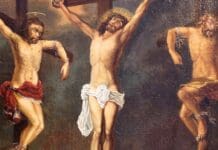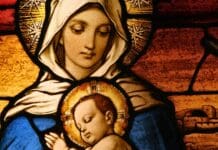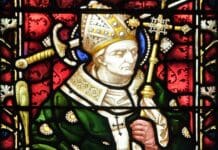For hundreds of years, Catholics observed the feast of the Assumption of the Blessed Virgin Mary on August 15 — celebrating Mary’s being taken bodily to Heaven after her death — but it was not until 1950 that the Church proclaimed this teaching a dogma of the Church — one of the essential beliefs of the Catholic faith.
August 15 is the day that Catholics have long celebrated what is called the Dormition (falling asleep) or Assumption of the Virgin Mary. The Feast of the Assumption celebrates both the happy departure of Mary from this life by her natural death, and her assumption bodily into heaven. Along with the Feast of the Immaculate Conception (December 8th) the Assumption is a principal feast of the Blessed Virgin and a Holy Day of Obligation — one of the most important feasts of the Church year.
The idea of the assumption of Mary into heaven after her death is first expressed in narratives of the fifth and sixth centuries. Even though these were never official, they bear witness to the very early belief in a teaching of the Catholic Church which was not formally defined as a dogma (a teaching essential to the Catholic faith) until 50 years ago.
Though it was almost universally believed for more than a thousand years, the Bible contains no mention of the assumption of Mary into heaven. The first Church writer to speak of Mary’s being taken up into heaven by God is Saint Gregory of Tours (594). Other early sermons on the Feast of Mary’s entry into heaven are those of Ps.-Modestus of Jerusalem (ca. 700).
On May 1, 1946, Pope Pius XII, asked all bishops in the world whether they thought this belief in the assumption of Mary into heaven should be defined as a proposition of faith, and whether they with their clergy and people desired the definition. Almost all the bishops replied in the affirmative.
On November 1, 1950, the Feast of All Saints, Pope Pius XII declared as a dogma revealed by God that “Mary, the immaculate perpetually Virgin Mother of God, after the completion of her earthly life, was assumed body and soul into the glory of Heaven”.
We have no real knowledge of the day, year, and manner of Our Lady’s death. The dates which have been assigned to her death vary between three and fifteen years after Christ’s Ascension. Both Jerusalem and Ephesus claim to be the place where she died. (By tradition, Mary lived at Ephesus after the death of Jesus.) Mary’s tomb was presumably found in Jerusalem. It is believed that Mary died in the presence of all the Apostles, but that after her burial, her tomb, when opened, was found empty. Therefore, they concluded that her body had been taken up (assumed) into heaven.
Saint Gregory of Tour provided a rationale for the tradition, which is related to her having been preserved from original sin. He said that it is inconceivable to think Mary’s sinless body, likened to the Ark of the Covenant which was made of incorruptible wood, should decay in the grave. The text, ‘Rise thou and the ark of thy strength’ (Ps 132/1:8) was understood to mean that it was God’s will that, as Christ had ascended, so too Mary would be received into heaven.
There is an important difference, of course, between the ascension of Jesus into Heaven after His Resurrection, and the assumption of Mary. To ascend is to rise up under one’s own power; while to be assumed means something that is done to one. Jesus, being the Second Person of the Trinity, had no need of assistance; whereas Mary did not have this power. (A pastor once demonstrated this difference in an unusual way. He asked two children to come to the front of the church. He told one child to walk from one side of the sanctuary to the other; and the other child he carried across.)
According to one tradition, Mary was warned of her approaching end by Saint Michael the Archangel, who conducts souls to Heaven, and was surrounded on her death-bed by the apostles, who were miraculously transported to her bedside from their various mission-fields. It was said that Jesus appeared, bore away her soul, and returned three days after her burial, when angels carried her body to Paradise where it was reunited with her soul under the Tree of Life.


















After we ate everyone gathered for the celebration.